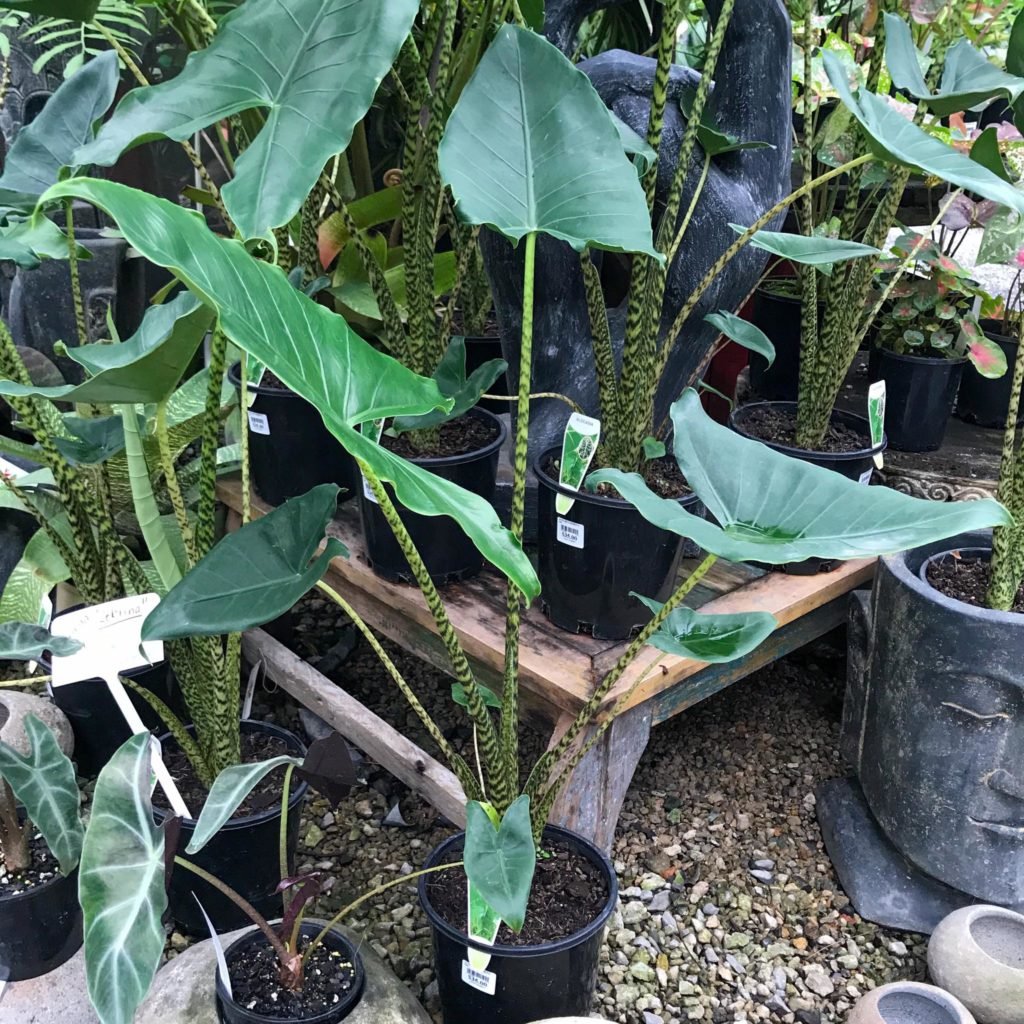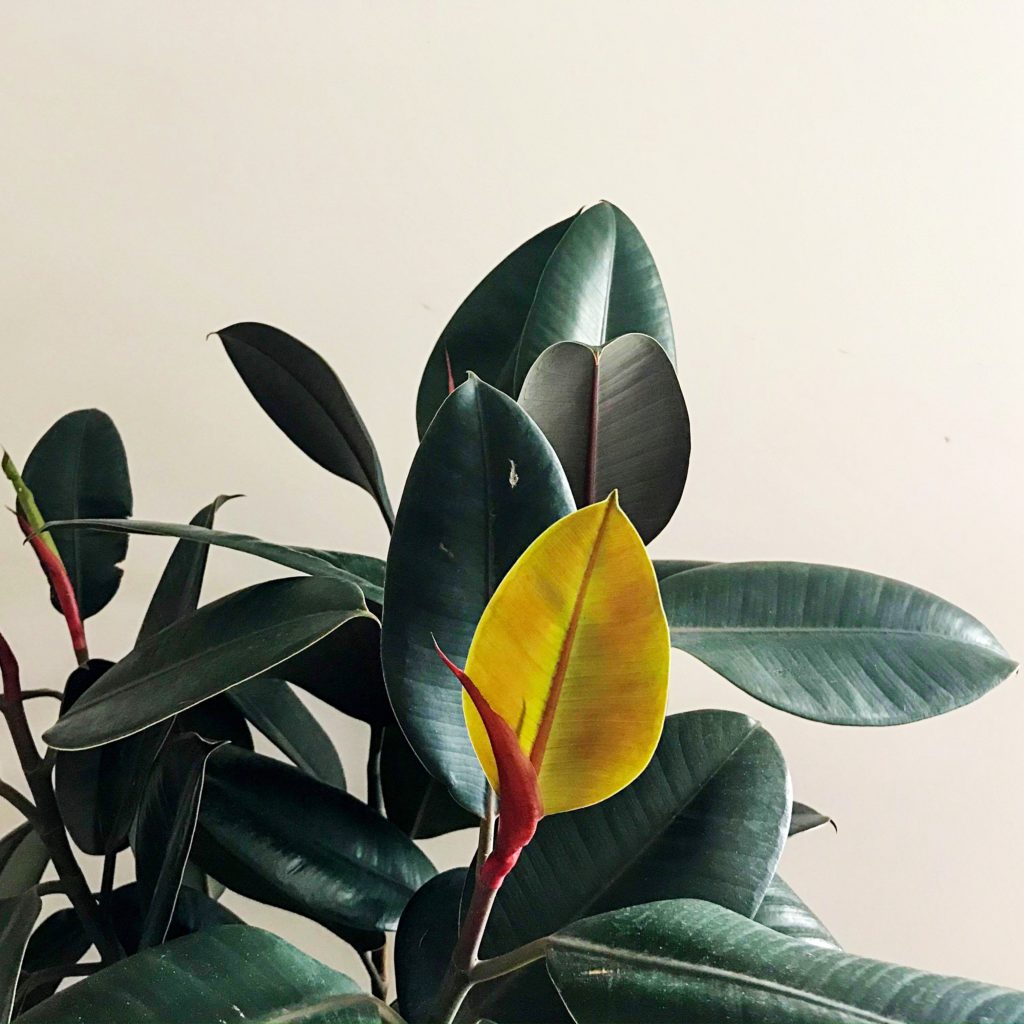Alocasia Zebrina, also known as Alocasia zebrina reticulata or the zebra plant, is a stunning indoor plant cherished for its distinctive patterned stems and large, arrow-shaped leaves.
This comprehensive guide will dive into every aspect of caring for this eye-catching tropical plant, including light, temperature, humidity, watering, fertilizing, soil, and pest management to give you the best chance possible for keeping this plant happy indoors.

Alocasia Zebrina Quick Care Overview
| Aspect | Requirement |
| Light | Bright, indirect |
| Temperature | 65-75°F (18-24°C) |
| Humidity | High (60% or higher) |
| Watering | Keep evenly moist |
| Fertilizing | Every 4-6 weeks |
| Soil | Well-draining |
| Toxicity | Toxic to pets |
Identification
Alocasia Zebrina can be easily recognized by its striking zebra-patterned stems, which feature alternating bands of light and dark colors. The plant’s large, arrow-shaped leaves are another distinguishing characteristic.
Alocasia Zebrina can be confused with other Alocasia species, but its unique striped stems set it apart.
Size
Alocasia Zebrina is known for its impressive size, with leaves reaching up to 2 feet in length and 1 foot in width. The plant can grow up to 3-4 feet tall, creating a bold statement in any indoor space. Its growth pattern is upright, with the leaves extending outward from a central stem.
Light Requirements
Alocasia Zebrina thrives in bright, indirect light. Place it near a north or east-facing window, or use sheer curtains to filter sunlight coming from south or west-facing windows.
Avoid direct sunlight, as it can scorch the plant’s delicate foliage. If the leaves appear to be reaching the light, rotate your plant periodically to ensure even growth.
Temperature Requirements
Alocasia Zebrina prefers a temperature range of 65-75°F (18-24°C). Avoid placing your plant near drafty windows, air conditioning vents, or heating sources, as extreme temperature fluctuations can cause stress.
Consider using a space heaters, grow lights or a greenhouse to maintain consistent temperatures for your plant in colder months.
Humidity Requirements
High humidity is essential for Alocasia Zebrina, with a recommended 60% or higher level. Place a humidifier near your plant or set it on a tray filled with pebbles and water to maintain adequate humidity. Signs of insufficient humidity include brown leaf tips or curling leaves.
Watering Requirements
Water your Alocasia Zebrina when the top inch of the soil feels dry, ensuring that it remains consistently moist but not soggy. During the growing season, you may need to water more frequently.
In winter, reduce watering as the plant enters dormancy. Overwatering can lead to root rot, while underwatering may cause leaves to turn yellow and wilt.
Fertilizing Requirements
Fertilize your Alocasia Zebrina every 4-6 weeks during the growing season, using a balanced liquid fertilizer diluted to half-strength. Signs of over-fertilizing include yellowing leaves or burnt leaf edges, while under-fertilizing may result in slow growth or pale foliage.
Soil Requirements
A well-draining soil mix is crucial for Alocasia Zebrina. A mixture of peat, perlite, and orchid bark can provide adequate drainage and aeration for your plant.
Alternatively, you can use a high-quality potting mix designed for tropical plants. To promote growth, add compost or worm castings to provide additional nutrients.
Repotting
Alocasia Zebrina may need to be repotted every 1-2 years as it grows. Choose a pot that is 1-2 inches larger in diameter than the current one and has drainage holes.
Repotting allows for fresh soil, encourages healthy root growth, and provides the opportunity to address any root or pest issues.
Diseases & Pests
Alocasia Zebrina is susceptible to various common indoor plant diseases and pests. It is essential to monitor your plant regularly for any signs of infestation or disease and treat them promptly to prevent further damage. Here are some common issues and their treatments:
Spider mites
These tiny pests feed on plant sap, causing yellowing, speckled leaves, and fine webbing on the foliage. To control spider mites, use insecticidal soap or neem oil to cover all plant surfaces.
You may need to repeat treatments every 7-10 days until the infestation is eliminated. Essential oils are another natural alternative method, find out more in our guide to essential oils for removing spider mites.
Mealybugs
These small, white, cottony insects cluster on leaves and stem, sucking plant sap and causing stunted growth or leaf drop. Remove mealybugs with a cotton swab dipped in rubbing alcohol, or treat them with insecticidal soap or neem oil.
Aphids
These small, soft-bodied insects feed on plant sap, causing deformed, yellowing leaves and the secretion of a sticky substance called honeydew.
Treat aphids with insecticidal soap or neem oil, focusing on the undersides of leaves where they tend to congregate.
Fungus gnats
These small, dark-colored flies are attracted to damp soil and can cause root damage in their larval stage. Allow the top layer of soil to dry out between waterings, and consider using a soil drench containing Bacillus thuringiensis (Bti) to control larvae.
Root rot
Caused by overwatering or poor drainage, root rot is a fungal disease that leads to yellowing, wilting leaves, and a foul smell from the soil.
To prevent root rot, ensure your plant has well-draining soil and avoid overwatering. Remove the affected roots if root rot is detected, and repot your plant in fresh, well-draining soil.
Propagation
Alocasia Zebrina can be propagated through division during repotting. Gently separate the offsets or baby plants growing at the base of the parent plant and pot them into their containers with well-draining soil. This is a great way to share your plant with friends or expand your collection.
Pruning
Regular pruning can help maintain the plant’s appearance and overall health. Remove yellowing or dead leaves by cutting them off at the base of the stem, using clean, sharp scissors, or pruning shears. This keeps your plant looking tidy and encourages new, healthy growth.
Dormancy
Alocasia Zebrina may enter a period of dormancy during winter months, with reduced growth and occasional leaf drop. Reduce watering and withhold fertilizer during this time until new growth appears in the spring.
Acclimation
If you’ve recently acquired an Alocasia Zebrina or moved it to a new location, give the plant some time to adjust to its new environment.
It’s not uncommon for plants to experience some leaf drop or stress during this period. Monitor the plant closely and maintain consistent care to help it acclimate successfully.
Toxicity
If ingested, Alocasia Zebrina contains calcium oxalate crystals, making it toxic to pets and humans. Keep the plant out of reach of children and pets to avoid accidental ingestion. If consumption occurs, seek medical attention or contact a poison control center immediately.
Common Problems
Alocasia Zebrina may encounter several common problems, which can be addressed with proper care and attention:
Yellowing leaves
Overwatering or poor drainage can cause leaves to turn yellow. Ensure your plant has well-draining soil, and allow the top inch of soil to dry out between waterings.
Drooping leaves
Underwatering or low humidity can lead to drooping leaves. Check the soil moisture regularly and maintain a high humidity level by using a humidifier or placing your plant on a pebble tray filled with water.
Brown leaf tips
Low humidity or over-fertilizing can cause brown leaf tips. Maintain a humidity level of 60% or higher and fertilize your plant every 4-6 weeks with a balanced liquid fertilizer diluted to half-strength.
Pale leaves
Insufficient light or under-fertilizing can result in pale, lackluster leaves. Place your plant in a location with bright, indirect light and fertilize it according to the recommended schedule.
Leggy growth
If your Alocasia Zebrina is not receiving enough light, it may become leggy and stretched as it reaches for the light. Ensure your plant is situated with bright, indirect light to encourage compact, healthy growth.
By addressing these common problems promptly, you can help your Alocasia Zebrina maintain its stunning appearance and thrive in your indoor space.
Conclusion
Caring for an Alocasia Zebrina can be a rewarding experience, with its eye-catching zebra-patterned stems and striking foliage adding a touch of the tropics to any indoor space. By following the guidelines in this comprehensive guide, you’ll be well-equipped to keep your Alocasia Zebrina healthy and vibrant.
For those interested in similar plants, consider exploring other Alocasia species or the closely related Colocasia genus.



